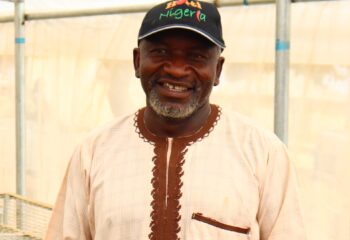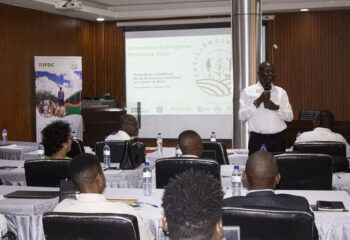Feb. 23, 2010 – MUSCLE SHOALS, Ala. – IFDC is launching the Virtual Fertilizer Research Center (VFRC), a global research initiative to create the next generation of fertilizers and production technologies, with initial financial support provided by the U.S. Agency for International Development. New and improved fertilizers are critical elements in the effort to help feed the world’s growing population, provide sustainable global food security and protect the environment.
The United Nations Population Division estimates that the global population is more than 6.8 billion and could reach 9.2 billion by 2050. More than 95 percent of the population growth is occurring in Africa and Asia, which already account for three-fourths of the global population. There is a finite limit of arable land, and even though land remains that could be converted to agricultural production (particularly in Africa), the environmental cost of doing so is increasing.
According to the Food and Agriculture Organization of the United Nations (FAO), the number of hungry people recently passed the one-billion mark – more than one-seventh of the world’s population. The number was growing before the global economic crisis, which has made the situation worse. The FAO estimates that Asia and the Pacific region have the largest number of hungry people – 642 million – followed by sub-Saharan Africa with 265 million.
“In 2008, the world struggled with food, fertilizer and fuel price crises that included dramatic price swings and shortages,” according to Dr. Amit H. Roy, IFDC president and CEO. “The crises have temporarily abated – largely due to the global recession. However, since the underlying causes remain, it is likely that these problems will re-emerge with economic recovery. Because of these crises, new and innovative research is needed to help feed the world. The time has come for developing practices and technologies to improve the use of land and labor resources, reduce emissions into the air and water and conserve natural resources.”
Roy continued, “These are global issues and they require global solutions. Therefore, IFDC is creating the VFRC as the most rapid, economical way to tap the world’s intellectual capacity to generate this critically needed fertilizer research.” Roy added, “The Center will partner with universities, public and private research laboratories and the global fertilizer and agribusiness industries to bring together the best scientific, business and government minds to create a research system producing more food with fewer wasted resources and a reduced environmental impact.”
With the population, economic and environmental issues facing it, the world cannot afford the current level of inefficiency in fertilizer production and use. It is estimated that 50 percent of the food consumed worldwide results directly from the use of (or benefits of) nitrogen fertilizer. Yet, only about one-third of the nitrogen fertilizer applied to crops in developing countries is utilized due to inefficiency in application methods and the inherent properties of current fertilizer products. The financial cost and waste burden farmers who pay for three times as much nutrient as their crops absorb. But that does not account for the total financial cost or waste. The “wasted” fertilizer does not disappear but often becomes an environmental pollutant, either in the form of potent greenhouse gas or runoff that fouls streams and lakes.
The production of one ton of urea, the predominant nitrogen fertilizer product, requires the energy equivalent of four barrels of oil. Inefficiencies in production and use result in less than 20 percent of the phosphate mined to produce phosphorus fertilizer ever becoming a part of the food chain. Yet, over the past 25 years, no “new” efficient fertilizer product has been developed – particularly no product affordable for use on food crops by farmers in less developed countries.
With a billion hungry people, it is unacceptable to condone such crop nutrient waste. With global climate change and declining biodiversity, it is also unacceptable to continue the unnecessary pollution of our environment. The world needs a “new generation” of fertilizer products and processes that make more efficient use of available resources.
In a January 2008 letter to Roy, the late Dr. Norman Borlaug, 1970 Nobel Peace Prize Laureate and father of the Green Revolution, said, “The work of the Green Revolution is not yet finished and I believe it will take a new round of technological advancement, political commitment, commercial development and a lot of hard work to complete the job.”
Borlaug’s letter to Roy continued, “We need to develop new products that will deliver just the nutrients that the growing plants require and to diminish environmental externalities. We need to invest in this sort of advanced fertilizer research and we need to coordinate it with advanced plant genetic research so that we can achieve synergy between more efficient use of available nutrients by plants and more efficient delivery of nutrients by fertilizer products. And we need to develop systems that can make these products cheaper and more accessible to farmers. We need to cut the cost of food production so that developing country farmers can produce affordable food to feed their growing urban populations.”
Dr. Jimmy Cheek, chancellor of the University of Tennessee in Knoxville (USA), has agreed to chair the Advisory Board of the VFRC. “The VFRC can develop a new suite of crop nutrients that will revolutionize agriculture in the developing world,” Cheek said. “I am proud to be associated with the effort and recognize its urgency and importance.”
Cheek was appointed chancellor of the University of Tennessee, a top public research university, in early 2009. Prior to his move to Knoxville, Cheek served as the senior vice president for agriculture and natural resources at the University of Florida, Gainesville (USA).
“It is fitting that IFDC is leading the global, virtual search for the next generation of crop nutrient products,” Roy stated. IFDC was created in October 1974 as a center of excellence with expertise in fertilizers to service the needs of developing countries. IFDC is an outgrowth of the National Fertilizer Development Center (NFDC) of the Tennessee Valley Authority (TVA). The majority of fertilizers in use worldwide were developed at the NFDC and/or IFDC.
IFDC was created during a period of crisis, similar to the crises that occurred in 2007-08. There were global food shortages in the early 1970s. Energy shortages were becoming commonplace, and fertilizers were also in short supply. The prices of agricultural inputs (fertilizers, seeds and crop protection products) needed to help produce food skyrocketed. All of these factors put the developing countries at a distinct disadvantage.
The world food supply has managed to stay ahead of rising population due to increasing productivity and a modest expansion of cultivated area. However, non-renewable resource reserves (such as phosphates and potash), increasing energy costs and the growing cost to the environment when bringing more land under cultivation pose new challenges. Fertilizer research and development can make a major contribution in addressing the challenges faced by Africa and Asia.
Global food security depends on a focused effort to improve soil fertility and increase productivity of food crops, and fertilizer plays a major role. The production and use of current fertilizer products must be improved. Recent advances in nanotechnology and biotechnology open new opportunities for collaborative research between the public and private sectors. To provide the world the next generation of fertilizers, the private sector must play a significant role in partnership with public institutions.



